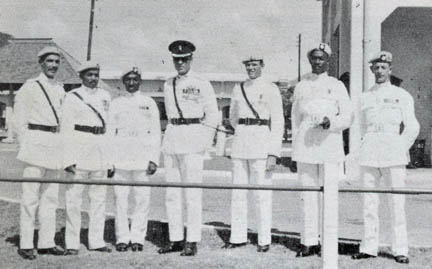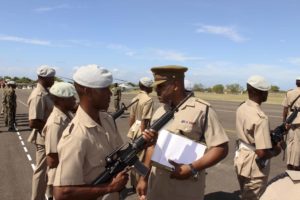|
History On 03 July 1963, the Jamaica Air Wing was officially formed with Captain Victor Beek (on secondment from the Ministry of Education) as its first and only member. On the 09 July 1963, Jamaica received four Cessna 185B aircraft through a Military Assistance Package from the US Government. These aircraft were painted white with blue trimmings, and had the national colours painted in bands over the wings. These aircraft were commissioned as JDF A-1, A-2, A-3 and A-4, and had arrived with two US Air Force pilot instructors (Captains Ban Hubbard and Gene Terry) for conversion training. The first notable mission was flown on 17 August 1963 in search of a ganja boat registered as ‘NANA’. It was not until September that the first enlisted soldier (Lance Corporal Scott) was posted to the unit as a driver, and hence became the first airman. The Jamaica Air Squadron initially operated these aircraft upon their arrival in Jamaica (since there was only one pilot in the Jamaica Air Wing at the time). They were eventually painted olive drab and taken over by the Jamaica Air Wing once additional Regular Force pilots were trained. The Jamaica Air Squadron then reverted to flying private aircraft belonging either to the club or to its members. Due to the mountainous nature of the island, it soon became apparent that helicopters would become a necessity for use by the JDF (and other government departments). On 11th October 1963 the first regular Officer Commanding arrived in Jamaica, Major Leslie Whittingham-Jones (along with his infamous dog ‘Boots’). He was a British Army Air Corps (AAC) helicopter instructor pilot whose task was to train helicopter pilots and organize the Jamaica Air Wing. Shortly thereafter, the first helicopter (JDF H-1, a Bell 47 G-3B-1) was delivered, and it was assembled in the JDF Workshop and pushed down the road to the Air Wing. A second helicopter (JDF H-2) was collected by JDF pilots (Robert Neish and George Brown) from Fort Worth, Texas in March 1964 and on a 1,900-mile journey back to Jamaica, amassing 40 flying hours (averaging 47.5 miles per hour). It was Major Whittingham-Jones who had instituted the wearing of the current distinctive light blue beret, and Captain Victor Beek (with his prior RAF service, and whom had previously started the Jamaica Combined Cadet Force Air Section in 1961) who had insisted on the wearing of RAF wings with ‘JDF’ (as opposed to ‘RAF’) inscribed, as remains the case today. The initial establishment (not then filled) was 6 pilots and 5 Technicians (1 WO1 Artificer, 1 Sgt Technician and 3 Technicians), and it was not long before the regular pilots became fully operational. The Jamaica Air Squadron then became the (current) Jamaica Defence Force Air Wing (National Reserve), and they continued to fly their own or rented aircraft. Throughout the years they have been providing sterling support to the operations of the regular JDF Air Wing. They now fly JDF aircraft and in fact provide many of the instructors for upgrading the Regular Force pilots. Most of them currently fly for Air Jamaica. On 17th May 1967 Major Robert ‘Bob’ Neish and Lieutenant Andrew Bogle (among the first JDF helicopter pilots) embarked on a very dangerous mission in the Blue Mountains to rescue a seriously injured soldier (Fusilier Hobbs). The area was so hilly and windy that the helicopter could not land, and during the ensuing rescue attempts, they lost control of the helicopter which resulted in them having to fly backwards in circles until they could conduct a safe run-on landing some ten miles away with the patient safely aboard the aircraft. They were then able to tie the patient down and fly on to a hospital. For this outstanding act of courage, skill and concentration, Major Neish was awarded the Air Force Cross (AFC), the highest flying award in the Commonwealth, and Lieutenant Bogle the Queen’s Commendation for Valuable Service in the Air. Having completed a decade of service with the initial fleet, and with an ever-increasing role for military aviation, the early seventies saw the Air Wing expanding its role with additional aircraft and pilots. Some Bell 206 (Jet Ranger) helicopters (which doubled the speed and seating capacity of the Bell 47G’s), and a De Havilland Twin Otter were acquired, which gave new meaning to Search and Rescue. The further acquisition of some much larger Bell 212 Helicopters, as well as two Islanders and a King Air now meant that overseas missions soon became commonplace for Air Wing (almost a weekly occurrence). The Jamaica Air Wing had remained all along a sub-unit of the Garrison Administrative Unit (which became the current Support and Services Battalion in 1973), and was to remain so until 1st April 1977 when it became an autonomous, self accounting Unit (The Jamaica Defence Force Air Wing) with its own Commanding Officer and commensurate establishment. The first Commanding Officer of the JDF Air Wing was Major Effiom B. Whyte. Other Commanding Officers over the years include Colonel AC ‘Bunny’ dev STERN (who logged more than 6,000 flying hours) who had for many years toiled to bring about the formation of the JDF Air Wing as an autonomous and professional unit and whose flying exploits and leadership are legendary. The Fixed Wing Flight (No. 1 Flight) moved their operations from Up Park Camp to the Norman Manley International Airport (JDF Air Wing Manley Base or ‘A1’) in May 1981 due mainly to flight safety concerns, and to reduce the general wear and tear on the aircraft from continuously operating from an unpaved airstrip. The new ‘Eagles Nest’ hanger was officially opened on 12 February 1988. Throughout the years the JDF Air Wing has benefitted from the professional services of various training institutions in the UK, Canada and the USA. Initially, along with Major Whittingham-Jones from the Army Air Corps (AAC), came an Artificer (WO1 Ashcroft) to conduct training for the technicians. Since then a long association has developed with the AAC for the training of the technicians up to Artificer level and pilots at Middle Wallop in England. Concurrently, the pilots also received training from the Canadian Forces Flight Training School initially in Rivers, Saskatchewan (on Hillier’s aircraft) and then in Portage-La-Prairie, Manitoba. Pilots started going regularly to Portage in 1972. The training of Jamaica Defence Force pilots in Canada ceased in April 2007. The Canadian Forces Central Flying School sends a team to Jamaica on an annual basis to assess the standards of the flying, maintenance and ground operations. This assessment ensures that the JDF AW maintains the same standards as other military aviation units throughout the world. The technicians also travel to Canada for the basic and upgrade training since 1981. The JDF Air Wing’s requirement for specific avionics training has also prompted the evolution of an avionics course including a POET course (Performance Oriented Electronics Training) held at CFB Kingston and a specialized avionics module held at CFB Borden. The JDF Air Wing has flown tens of thousands of hours on countless missions since its formation, including flying members of the British monarch and several heads of states (including HRH Prince PHILLIP, and HRH Prince CHARLES). JDF Air Wing has flown countless search and rescue missions, transferring thousands of critically injured patients across Jamaica (and from Grand Cayman and St Kitts) participated in the interdiction of hundreds of millions of US dollars worth of narcotics, and found many fishermen lost at sea. The JDF Air Wing has also provided disaster relief for thousands of Jamaicans during and after natural disasters; assisted in General Elections in Haiti; moved thousands to include soldiers, policemen, cameramen, journalists and athletes. It has taken the JDF team to the International Military Boxing Competition in Panama in October 1981; parachutists, doctors and blood to Grand Cayman on Christmas morning in 1963; flown foreign investors, surveyors, town planners, VIPs and international personalities, including General Colin Powell, Johnnie Cochran, Patrick Ewing, Henry Kissinger, and Lord Louis Mountbatten; as well as lifted special equipment into difficult areas. Several large government infrastructure projects have utilized the assets of the JDF Air Wing, including the Yallahs Pipeline and the Hermitage Dam to name a few. On 07 Dec 06 the Jamaica Military Aviation School was opened by Minister of National Security, Hon Dr Peter PHILLIPS for the purpose of training pilots to Wings Standard in Jamaica. It was made possible through extensive help from the Canadian Forces MTAP which provided Courseware, IT and instructor courses. Infrastructure and 2 Diamond 40FP were provided by the Government of Jamaica. To accomplish all these missions and operations, the JDF Air Wing has trained many pilots, maintenance and ground crew. Many of these individuals continue to make major contributions to the aviation community in Jamaica (and overseas), especially at Air Jamaica. From carrying one patient at a time in a wire basket hanging on the outside of the skid of a Bell 47G helicopter (with the wind blowing on them) and sometimes following railways lines into Kingston in 1963, to being able to winch six patients on stretchers into a Bell 412EP helicopter (whilst filming it with Infra-Red equipment) and navigating through IFR conditions with 4-axis autopilot, EFIS, Doppler and a coloured weather radar in 2003, the JDF Air Wing has come a long way. The unit currently averages 2,100 flying hours per year. The Jamaica Defence Force Air Wing has proven its worth as an asset to the JDF and the nation. We fly for all. In 2007/2008 the JDF AW replaced its four (4) Eurocopter Ecuriel helicopters with four (4) Bell 407’s, bringing this Unit back to an all Bell fleet. In addition a Bell 206b was purchased for use at JMAS for helicopter training. Thus on 17 Jan 09 JMAS graduated its first Wings class and the first female pilot in 28 years.
|
|






